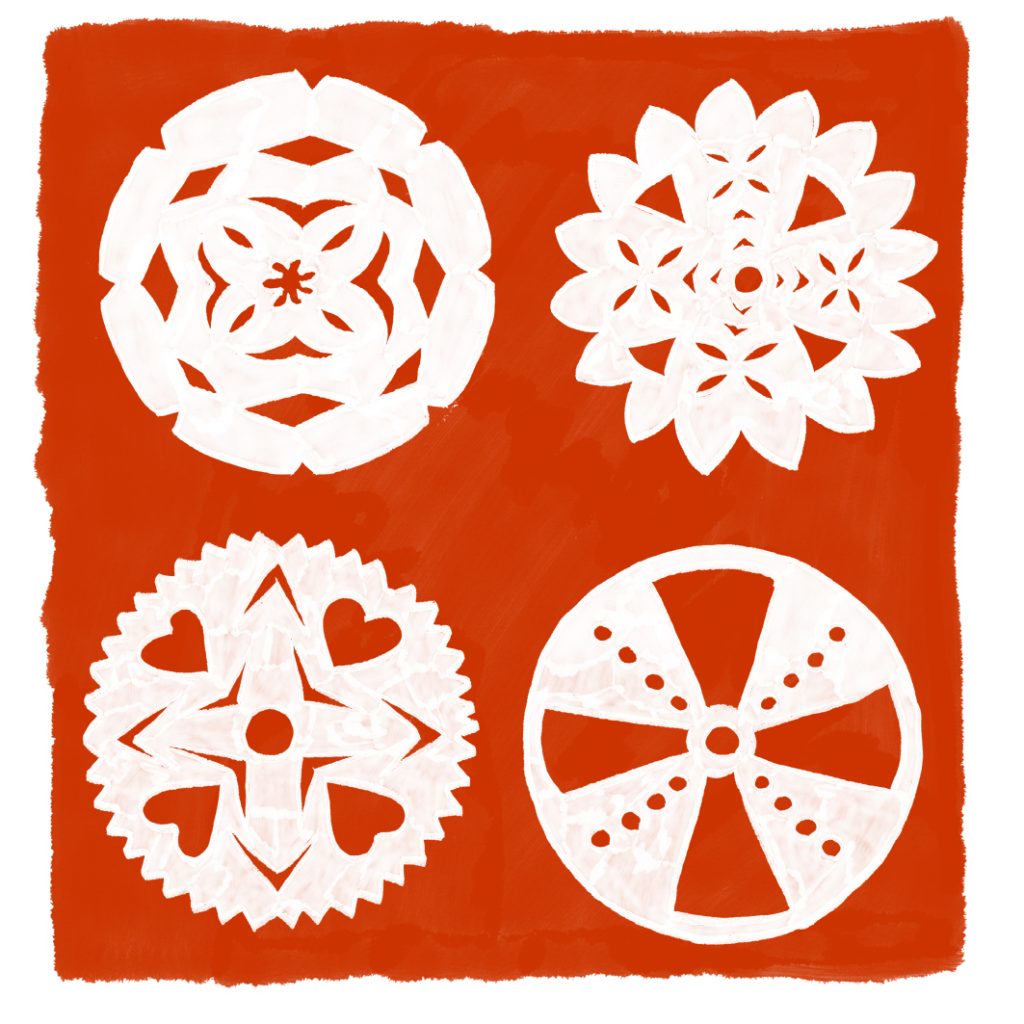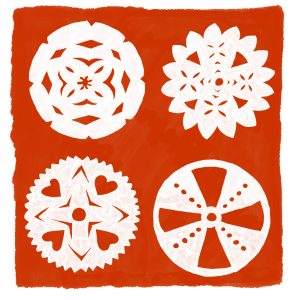
Neules
cada cosa en es seu temps i per Nadal, neules.
Les neules són la típica decoració nadalenca per les cases i les esglésies mallorquines. Actualment quasi totes les neules són de paper, però a l’època dels nostres padrins eren fetes amb pasta de farina. A veure, per la gent que no sap què és una neula, imagineu-vos una hòstia, però una mica més gran. En feien d’insípides o bé afegien una mica de sucre i canyella per donar un poc de dolçor a aquella pasta fina. Les neules també són la base dels “barquillos” i també s’utilitzen per fer el cobriment des torró d’ametlla (o coca de torró), fet d’ametlla, sucre, ou i suc de taronja… Una meravella.
Hi ha famílies que encara conserven neules de l’època de la padrina i, òbviament, les guarden en un bon canterano. Les neules heretades de tradició familiar solen ser unes neules de paper (afortunadament no són les de farina…) molt ben fetones i ben retallades que feien les monges dels convents del poble. Ara hi ha de tot, fins i tot és una bona activitat per fer amb els nins. Depenent de la perícia de cada nin, la feina es pot complicar més o menys: trobem les neules plenes, que són les llises, o bé trobem les que estan troquelades amb escenes nadalenques del betlem o amb motius geomètrics
Les neules decoren les esglésies de l’illa i els seus betlems i amb elles s’han aconseguit muntatges espectaculars que ni els millors escenògrafs europeus mai haguessin pogut imaginar. Amb un tros de paper es poden aconseguir meravelles i efectes visuals potentíssims. Així doncs, trobem cascades de neules caient des de la bóveda central de les esglésies mallorquines, metres i metres de fil d’on pengen aquestes figures blanques que poden recordar a flocs de neu. Realment són escenografies que només poden sortir del cap del sector eclesiàstic, estem davant de segles de tradició on històricament sempre s’ha buscat un efecte colpidor per als feligresos. La parròquia de Porreres és on he vist una de les decoracions amb neules més espectaculars, visitar-la és una experiència altament recomanable, però també en podeu trobar per Palma, a l’església de Sant Francesc o a la de Santa Eulàlia.
Passat festes, la cascada de neules es retirava i quedaven penjades unes quantes en el presbiteri o el llanterner central del temple. Quedaven tantes neules com setmanes faltaven per l’arribada de la Quaresma. Representaven un calendari fet de menjar que t’anunciava quantes setmanes et quedaven per al dejuni quaresmal, quina paradoxa!
Com a fet curiós, antigament les neules de farina eren les que penjaven davant de l’altar on la Sibil·la cantava per matines. La Sibil·la sempre canta amb una espasa i anuncia l’apocalipsis i l’arribada del Senyor. En aquella època, en acabar la Sibil·la el seu cant, amb un moviment d’espasa sever tallava les neules que tenia just enfront, que queien damunt del públic fent l’efecte que baixaven del cel per ser menjades. Suposem que això causava molt rebombori dins les esglésies. Que fos habitual pegar-se un parell de colzades amb el veí el dia de matines per una hòstia suposo que va fer anar desapareixent aquest costum…
It is Christmas and therefore it is neules time.
Neules are the typical Christmas decoration we put in Majorcan houses and churches. Nowadays, most neules are made of paper, but years ago they were made with some kind of flour paste. For people who don’t know what a neula is, you have to imagine a piece of altar bread, but slightly bigger. They’d make them either tasteless or with a bit of sugar and cinnamon to add a bit of sweetness to the thin paste. Neules are also the base of barquillos and they are used to cover the torró d’ametlla or coca de torró – a sweet flat cake we prepare during Christmas time with almonds, sugar, eggs and orange juice… wonderful!
Some families still conserve the old neules from their grandmas’ and they obviously keep them in a canterano. The inherited neules, though, are usually the paper ones (and not the flour ones, luckily!) and they often are the ones that the nuns of the village made very meticulously. Today, we can find all sorts of things since making neules can even be a fun family activity for children. Depending on the proficiency of every kid, it can get more or less complicated: we can find full neules, which are plain, or the ones that are die-cut with Christmassy scenes or with geometric motifs.
Neules decorate the churches of the island and their nativity scenes and with them they have done spectacular assemblies that the best European set designers couldn’t have even imagined. Just with a piece of paper you can achieve wonders and very powerful visual effects. Hence, we can find waterfalls made of neules falling from the central vault of the church, metres and metres of thread where these white figures that can remind of a snowflake hang from. They really are scenographies that can only come from the ecclesiastic mind, as we are talking about centuries of tradition that has historically always sought a shocking effect for the parishioners. The church of Porreres is where I have seen one of the most spectacular decorations with neules, a visit is highly recommended, but you can find them also in Palma, at the church of Sant Francesc or Santa Eulalia.
After the holidays, the neules waterfall was removed but a few neules were left hanging from the chancel of the church and the central lantern. The number of remaining neules corresponded to the number of weeks left until Lent. They represented a calendar made of food that announced the number of weeks left until the Lent starvation, how paradoxical!
Fun fact is that formerly flour neules were the ones that hanged in front of the altar where the Sibil·la sang for matines. The Sibil·la always sings with a sword and announces the apocalypse and the arrival of the Lord. In those times, when the sibil·la finished the song, she would cut the neules that she had just in front with a severe sword move, and these would fall onto the public making the effect that they fell from heaven to be eaten. This might have caused some concern in the churches. I suppose that the normality with which people would kick each other on the matines day to get an altar bread made the tradition disappear with time…
Text by benmallorqui.com


+ There are no comments
Add yours